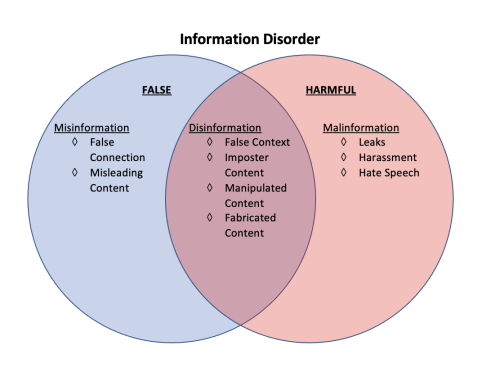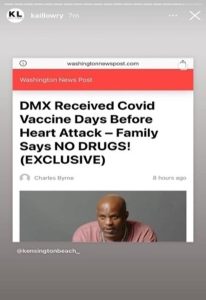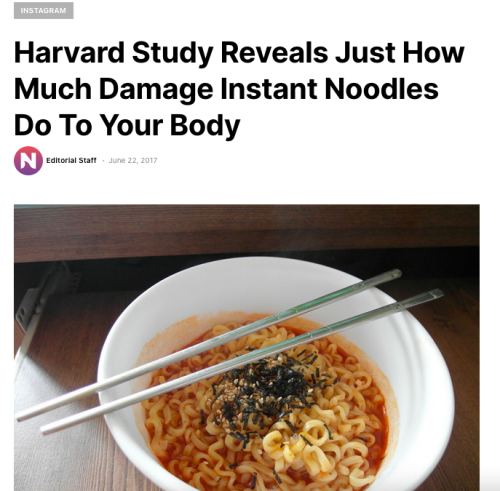1.3 Information Disorder
“In the digital sphere, all sources – whether reputable or not – can appear equal” (Gibbs & Castillo, 2021, p. 5). Knowing this, individuals who enjoy creating chaos and who intend to cause harm, can do so very easily. The spread of false information on the Internet occurs at a rapid pace and has been described by experts under the collective term information disorder, which encompasses misinformation, disinformation and malinformation. The diagram below shows that there is overlap between the three concepts. Together they encompass the creation and sharing of false information by individuals or artificial intelligence for various purposes (Stecula, 2021). The element that differs between the concepts is the creator’s intent.

1.3.1 Misinformation
Misinformation is information that is false, but the person sharing it believes it is true. It may be incorrect or incomplete and the creator or sharer might not know that the information is untrue (Gibbs & Castillo, 2021). All people are vulnerable to misinformation, including people who are highly educated and very involved in thinking about these things. (Stecula, 2021). It is less dangerous than its partner concepts but can cause confusion and contribute to information overload because it can spread quickly on social media (Chen et al., 2015; Pennycook et al., 2018; Thomson & Finnegan, 2020).
Here is an example of misinformation. An individual receives a COVID-19 vaccine, they then post on their social media channel that they “got Moderna and now feel SUPER SICK, don’t get that one!” Their social media circle might react in multiple ways. Someone may react by posting that they got Moderna, and it was totally fine. Another person may tell people in other social groups that they heard someone got Moderna and felt sick. A third person may silently store this information to be used when needed and find themselves at the vaccine clinic requesting Pfizer instead of Moderna, but not remembering why. Meanwhile, the original poster, the one who got vaccinated and posted about it, realizes that they had actually received a Pfizer vaccine.
This sort of occurrence is not that dangerous. But the post may have prevented an individual from getting vaccinated in a timely manner; it might have even spread this misinformation to other people. It has the potential to cause confusion, but it’s not purposefully harmful.
1.3.2 Disinformation
Disinformation is information that is false. The person creating it knows it to be false and shares it with intent to cause harm (Gibbs & Castillo, 2021). It is made up of deliberate, intentional lies. The creators of disinformation intend for those who engage with the information to be persuaded to a certain viewpoint (Chen et al., 2015; Wardle & Derakhshan, 2018). In the Internet age, disinformation spreads quickly due to the various players who might get involved including trolls, troll farms, bots, spoofers, influencers, governments, and normal citizens. It is often made up of exciting headlines that stir emotion and which people share with very little thought (Stecula, 2021). Those who are the most skilled at creating disinformation can easily make it appear sophisticated and well-researched, even when it isn’t.
Here is an example of disinformation. In 2017, following the day of his inauguration (when he was sworn in as President of the United States [US]), Donald Trump said that his ceremony was the biggest of all time (it wasn’t). It was later revealed that images of the day (which had been published online in various places) had been altered to make it appear that his crowd was a similar size to his predecessor, Barack Obama’s (Finnis, 2021). Over time, the doctoring of images and constant barrage of Donald Trump’s supporters claiming that his inauguration was a highly attended event, led to confusion, belief in false information and even more dangerously, disengagement with the truth. The facts are:
- Donald Trump’s inauguration: 600,000 people in attendance (left) (Finnis, 2021)
- Barack Obama’s inauguration: 1.8 million people in attendance (right) (Finnis, 2021).

The creators of disinformation create and share it for various reasons, many of which are unknown, but some of which include financial gain and public notoriety (Buchanan & Benson, 2019). In the case of Donald Trump, he is famed for doing whatever he can to ensure that everyone believes whatever he says, whether it is true or not.
1.3.3 Malinformation
Malinformation can be used to describe two different situations. The first occurs when real information is slightly altered or misrepresented to cause harm to a specific country, organization, or person (Chen et al., 2015; Wardle & Derakhshan, 2018). The second situation occurs when true and private information is ‘leaked’ at a particular moment with the intent to create a large effect (Bajwa, 2021; Stecula, 2021). An example of ‘leaked’ information is personal videos or emails that are released to the public. The concept of malinformation is difficult to understand and gets even more confusing because much of it that appears online disappears when people become aware of its falseness.
Here is an example of malinformation where real information is altered to cause harm. Since the release of the COVID-19 vaccine, fake news sites have been linking deaths and side effects (such as infertility) to ‘getting the jab’. These sites will find a story about a person who received the COVID-19 vaccine, then died in a car accident three hours later, and create a new story with a headline “woman dies 3 hours after receiving COVID-19 vaccine!!!” They do not care about a direct correlation to the actual vaccine and they do not care how long the story stays up. It only takes a couple clicks and shares to make a post viral and convince people of its truth.
This occurred in March 2020, when rapper DMX died of a massive heart attack. In the couple of months following his death, basic Internet searches were not successful in identifying the cause. His family took to the press denying that the heart attack was induced by a drug overdose (a common assumption). They deflected and mentioned that the rapper had received his COVID-19 vaccine a week prior to his death. A connection between his death and the COVID-19 vaccine began and spread on social media and reality star Kailyn Lowry shared a headline in her Instagram Stories:

In the weeks following the publication of this and other articles like it, the story connecting the vaccine to DMX’s death disappeared completely. No trustworthy sources have verified that DMX’s heart attack was related to getting the COVID-19 vaccine. In fact, no sources can verify that he received the vaccine at all and articles linking his death to the vaccine no longer exist, but for those who read and believed them, the damage is done. Numerous sources now corroborate that the heart attack was the result of a cocaine overdose (Frishberg, 2021; Bekiempis, 2021; Robinson, 2021). The vaccine-death connection only existed for a moment in Internet time, but it likely caused real damage.
1.3.4 Deformation
Information disorder can also be created by taking information apart, this is called deformation. It occurs when someone shares a part of a story, out of context, and makes that portion appear as a fact (Brennen, 2020). Twitter’s word count limit lends itself to ‘deformation’ because it is challenging to explain complex concepts in 280 characters (Brennen, 2020).
Here is an example of deformation. An Instagram story in 2017 emphasized the risks of consuming ramen noodles. The caption claimed a Harvard study revealed that ramen does damage to the body, but the statement is not true. The study was not associated with Harvard and it has never been repeated–meaning it doesn’t follow the scientific method. A careful review of the entire study reveals that there is no way to isolate ramen as the sole cause of the adverse health effects (LaCapria, 2016). By trying to report on a complex study, this Instagram story does not provide enough information to give an accurate explanation of the real findings.

1.3.5 Propaganda
Propaganda is a term for information that is manipulated to influence and control a target group of people over a long period of time (Gibbs & Castillo, 2021). This often occurs by presenting facts selectively, sharing partial facts and omitting certain facts. A propaganda campaign has a leader, a set purpose and a goal. O’Connor and Weatherall (2019) define propaganda as “material produced by a government or political organization, to promote a particular viewpoint–or to challenge one” and they point to the fact that much misinformation takes the form of propaganda (p. 9). Adolf Hitler, for instance, developed an entire Ministry of Propaganda (called the Reich Ministry of Public Enlightenment and Propaganda) under which Nazi agenda dictated all information given to the German public from 1933-1945 – they controlled films, theatre, music and the press (United States Holocaust Museum, n.d.).
Another form of propaganda is industrial propaganda which appears as advertising and campaigns to undermine truth and evidence. Big Tobacco’s decades long advertising campaign, which sought to misinform people about the harms of its products, is an example of this type of propaganda (O’Connor & Weatherall, 2019). In chapter five we will discuss the successful efforts by major tobacco companies who created confusion, doubt, pseudo-science and propaganda to ensure that they would continue to profit off of tobacco sales, even as scientific evidence pointed to the now well-known health concerns related to their products.
Concepts discussed in this chapter have existed throughout history. Misinformation, disinformation, malinformation, deformation and propaganda are distinctive and frightening trends which flourish in the Internet age, but they are not new. They are increasing and have become a repetitive, sometimes inescapable, aspect of everyday life. The next section examines instances of disinformation throughout history to highlight its consistent presence and to shed light on how, in the Internet age, false information has the potential to spread at an alarming rate.
A phenomenon consisting of three concepts: misinformation, disinformation, and malinformation. Together, they encompass the creation and sharing of false information, by individuals or artificial intelligence, for various purposes.
Information that is false but the person sharing or creating this information believes it to be true.
False or inaccurate information, created and shared by someone with the intent to cause harm.
Information that is based on something factual but has been altered in order to cause harm to a specific organization, group, or person.
A phenomenon that occurs when information is taken apart, and pieces of that information are shared outside of the original context, creating a different meaning.
A term for information that has been manipulated or created (usually by political organizations) with the intention to sway social or political opinions or conversations.

